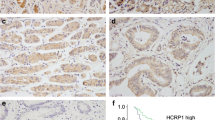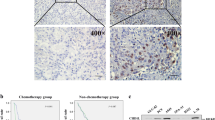Abstract
Chemoresistance is a major cause of treatment failure and high mortality in advanced gastric cancer (AGC). Currently, the mechanism of chemoresistance remains unclear, and there is no biomarker to accurately predict the efficacy of chemotherapy. In the present study, we established human gastric cancer (GC) cell lines resistant to 5-fluorouracil (5FU), paclitaxel (TA), or cisplatin (DDP) by gradient drug treatment and generated a novel monoclonal antibody 5B2 targeting heterogeneous nuclear ribonucleoproteins C1/C2 (HNRNPC) overexpressed in chemoresistant GC cells. Overexpressing HNRNPC in GC cells promoted chemoresistance, and knockdown of HNRNPC by small interfering RNA (siRNA) reversed chemoresistance. By utilizing available datasets, we demonstrated that high level of HNRNPC transcript indicated poor overall survival (OS) and free of progression (FP). HNRNPC expression was negatively correlated with OS of GC patients treated with 5FU-based drugs and with time to progression (TTP) of GC patients treated with CF regimen. These data suggest the potential usefulness of HNRNPC as a prognostic and therapeutic marker of GC.




Similar content being viewed by others
References
Torre LA, Bray F, Siegel RL, Ferlay J, Lortet-Tieulent J, Jemal A. Global cancer statistics, 2012. CA Cancer J Clin. 2015;65(2):87–108.
Karimi P, Islami F, Anandasabapathy S, Freedman ND, Kamangar F. Gastric cancer: descriptive epidemiology, risk factors, screening, and prevention. Cancer Epidem Biomar. 2014;23(5):700–13.
Lustosa SA, Saconato H, Atallah AN, Lopes Filho Gde J, Matos D. Impact of extended lymphadenectomy on morbidity, mortality, recurrence and 5-year survival after gastrectomy for cancer. Meta-analysis of randomized clinical trials. Acta Cir Bras. 2008;23(6):520–30.
Garrido M, Fonseca PJ, Vieitez JM, Frunza M, Lacave AJ. Challenges in first line chemotherapy and targeted therapy in advanced gastric cancer. Expert Rev Anticancer Ther. 2014;14(8):887–900.
Kim JG. Molecular targeted therapy for advanced gastric cancer. Korean J Intern Med. 2013;28(2):149–55.
Wong R, Cunningham D. Optimising treatment regimens for the management of advanced gastric cancer. Ann Oncol Off J Eur Soc Med Oncol ESMO. 2009;20(4):605–8.
Geng R, Li J. Apatinib for the treatment of gastric cancer. Expert Opin Pharmacother. 2015;16(1):117–22.
Zheng L, Tan W, Zhang J, Yuan D, Yang J, Liu H. Combining trastuzumab and cetuximab combats trastuzumab-resistant gastric cancer by effective inhibition of EGFR/ErbB2 heterodimerization and signaling. Cancer Immunol Immunother CII. 2014;63(6):581–6.
Zhang D, Fan D. New insights into the mechanisms of gastric cancer multidrug resistance and future perspectives. Future Oncol. 2010;6(4):527–37.
Krueger P, Nitz C, Foster R, MacDonald C, Gelber O, Lalehzadeh G, et al. A new small cell lung cancer (SCLC)-specific marker discovered through antigenic subtraction of neuroblastoma cells. Cancer Immunol Immunother CII. 2003;52(6):367–77.
Mattes MJ, Look K, Furukawa K, Pierce VK, Old LJ, Lewis Jr JL, et al. Mouse monoclonal antibodies to human epithelial differentiation antigens expressed on the surface of ovarian carcinoma ascites cells. Cancer Res. 1987;47(24 Pt 1):6741–50.
Yin BW, Kiyamova R, Chua R, Caballero OL, Gout I, Gryshkova V, et al. Monoclonal antibody MX35 detects the membrane transporter NaPi2b (SLC34A2) in human carcinomas. Cancer Immun. 2008;8:3.
Zhao W, Wang L, Han H, Jin K, Lin N, Guo T, et al. 1B50-1, a mAb raised against recurrent tumor cells, targets liver tumor-initiating cells by binding to the calcium channel alpha2delta1 subunit. Cancer Cell. 2013;23(4):541–56.
Harris M. Monoclonal antibodies as therapeutic agents for cancer. Lancet Oncol. 2004;5(5):292–302.
Butte A. The use and analysis of microarray data. Nat Rev Drug Discov. 2002;1(12):951–60.
Szoke D, Gyorffy A, Surowiak P, Tulassay Z, Dietel M, Gyorffy B. Identification of consensus genes and key regulatory elements in 5-fluorouracil resistance in gastric and colon cancer. Onkologie. 2007;30(8–9):421–6.
Kim HK, Choi IJ, Kim CG, Kim HS, Oshima A, Michalowski A, et al. A gene expression signature of acquired chemoresistance to cisplatin and fluorouracil combination chemotherapy in gastric cancer patients. PLoS One. 2011;6(2):e16694.
Kim JG, Chung HY, Yu W. Recent advances in chemotherapy for advanced gastric cancer. World J Gastrointest Oncol. 2010;2(7):287–94.
Shekhar MP. Drug resistance: challenges to effective therapy. Curr Cancer Drug Targets. 2011;11(5):613–23.
Xu HW, Xu L, Hao JH, Qin CY, Liu H. Expression of P-glycoprotein and multidrug resistance-associated protein is associated with multidrug resistance in gastric cancer. J Int Med Res. 2010;38(1):34–42.
Cascinu S, Graziano F, Del Ferro E, Staccioli MP, Ligi M, Carnevali A, et al. Expression of p53 protein and resistance to preoperative chemotherapy in locally advanced gastric carcinoma. Cancer. 1998;83(9):1917–22.
Matsuhashi N, Saio M, Matsuo A, Sugiyama Y, Saji S. The evaluation of gastric cancer sensitivity to 5-FU/CDDP in terms of induction of apoptosis: time- and p53 expression-dependency of anti-cancer drugs. Oncol Rep. 2005;14(3):609–15.
Shen XM, Zhou C, Lian L, Li LQ, Li W, Tao M. Relationship Between the DPD and TS mRNA Expression and the Response to S-1-Based Chemotherapy and Prognosis in Patients with Advanced Gastric Cancer. Cell Biochem Biophys. 2014.
Canadas I, Rojo F, Taus A, Arpi O, Arumi-Uria M, Pijuan L, et al. Targeting epithelial-to-mesenchymal transition with Met inhibitors reverts chemoresistance in small cell lung cancer. Clin Cancer Res Off J Am Assoc Cancer Res. 2014;20(4):938–50.
Dean M, Fojo T, Bates S. Tumour stem cells and drug resistance. Nat Rev Cancer. 2005;5(4):275–84.
Yoon JH, Ahn SG, Lee BH, Jung SH, Oh SH. Role of autophagy in chemoresistance: regulation of the ATM-mediated DNA-damage signaling pathway through activation of DNA-PKcs and PARP-1. Biochem Pharmacol. 2012;83(6):747–57.
Yang Y, Li H, Hou S, Hu B, Liu J, Wang J. The noncoding RNA expression profile and the effect of lncRNA AK126698 on cisplatin resistance in non-small-cell lung cancer cell. PLoS One. 2013;8(5):e65309.
Burd CG, Swanson MS, Gorlach M, Dreyfuss G. Primary structures of the heterogeneous nuclear ribonucleoprotein A2, B1, and C2 proteins: a diversity of RNA binding proteins is generated by small peptide inserts. Proc Natl Acad Sci U S A. 1989;86(24):9788–92.
Liang CR, Leow CK, Neo JC, Tan GS, Lo SL, Lim JW, et al. Proteome analysis of human hepatocellular carcinoma tissues by two-dimensional difference gel electrophoresis and mass spectrometry. Proteomics. 2005;5(8):2258–71.
Rajagopalan LE, Westmark CJ, Jarzembowski JA, Malter JS. hnRNP C increases amyloid precursor protein (APP) production by stabilizing APP mRNA. Nucleic Acids Res. 1998;26(14):3418–23.
Lee SY, Park JH, Kim S, Park EJ, Yun Y, Kwon J. A proteomics approach for the identification of nucleophosmin and heterogeneous nuclear ribonucleoprotein C1/C2 as chromatin-binding proteins in response to DNA double-strand breaks. Biochem J. 2005;388(Pt 1):7–15.
Christian KJ, Lang MA, Raffalli-Mathieu F. Interaction of heterogeneous nuclear ribonucleoprotein C1/C2 with a novel cis-regulatory element within p53 mRNA as a response to cytostatic drug treatment. Mol Pharmacol. 2008;73(5):1558–67.
Blume SW, Jackson NL, Frost AR, Grizzle WE, Shcherbakov OD, Choi H, et al. Northwestern profiling of potential translation-regulatory proteins in human breast epithelial cells and malignant breast tissues: evidence for pathological activation of the IGF1R IRES. Exp Mol Pathol. 2010;88(3):341–52.
Sell C, Rubini M, Rubin R, Liu JP, Efstratiadis A, Baserga R. Simian virus 40 large tumor antigen is unable to transform mouse embryonic fibroblasts lacking type 1 insulin-like growth factor receptor. Proc Natl Acad Sci U S A. 1993;90(23):11217–21.
Park YM, Hwang SJ, Masuda K, Choi KM, Jeong MR, Nam DH, et al. Heterogeneous nuclear ribonucleoprotein C1/C2 controls the metastatic potential of glioblastoma by regulating PDCD4. Mol Cell Biol. 2012;32(20):4237–44.
Acknowledgments
We deeply appreciate Dr. Györffy (Semmelweis University, Budapest, Hungary) and Dr. Green JE (Transgenic Oncogenesis and Genomics Section, Center for Cancer Research, National Cancer Institute) for providing gene expression datasets of gastric cancer patients. This study was supported by National Basic Research Program of China (2015CB553906).
Author information
Authors and Affiliations
Corresponding author
Ethics declarations
Conflicts of interest
None
Additional information
Hao Huang and Yong Han contributed equally to this work.
Rights and permissions
About this article
Cite this article
Huang, H., Han, Y., Zhang, C. et al. HNRNPC as a candidate biomarker for chemoresistance in gastric cancer. Tumor Biol. 37, 3527–3534 (2016). https://doi.org/10.1007/s13277-015-4144-1
Received:
Accepted:
Published:
Issue Date:
DOI: https://doi.org/10.1007/s13277-015-4144-1




